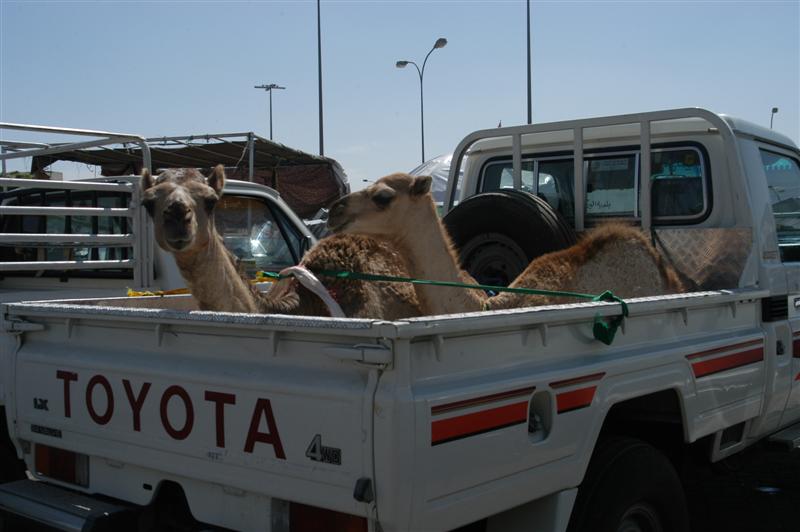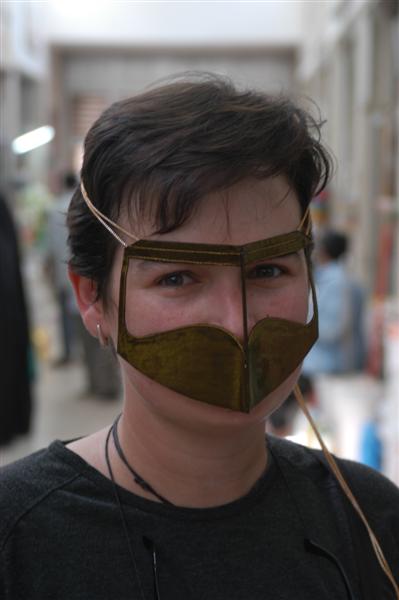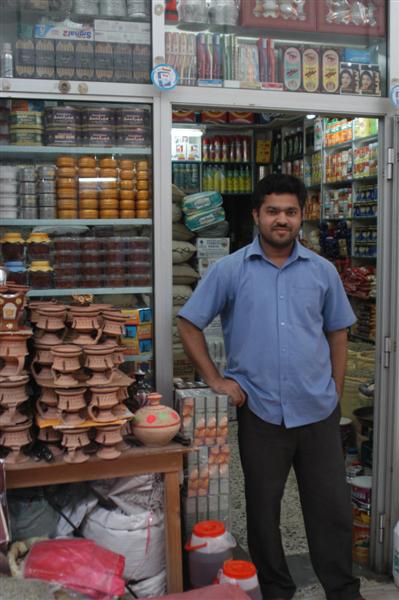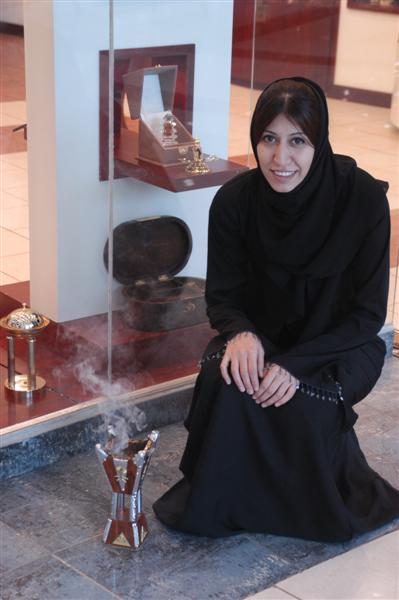October 21. AL AIN "A Small Omani Market" (Buraimi, Oman) One of our main motivations for visiting Al Ain was to pop over to the border town of Buraimi in Oman. We had hoped to visit Muscat and other parts of northern Oman but after a week of Ramadan in the UAE we knew that it would be more difficult in Oman. A more traditional country that is less developed for tourism, Oman sounded like a great off-the-beaten-track destination but Ramadan just didn't seem like the right time to go. We decided to limit our experience of Oman to the Buraimi, just a brief peek but something nonetheless. for tourism, Oman sounded like a great off-the-beaten-track destination but Ramadan just didn't seem like the right time to go. We decided to limit our experience of Oman to the Buraimi, just a brief peek but something nonetheless.
In the morning Rob went down for breakfast. It was daylight already but they had covered the windows of the hotel restaurant so those who wanted to eat wouldn't offend those who didn't. The hotel appeared to be mostly western expats, many with children. It was probably a cheap holiday away from the big cities. The pool area looked particularly inviting and with so many people in bathing suits I didn't think it would be uncomfortable to take a swim. That left us with a small dilemma. We really wanted to see Buraimi but felt that we were short changing our experience at the hotel not to enjoy the facilities. Really we were just getting a bit spoiled and wanted to justify another night at the Intercontinental, which we did.
Before it got too late we jumped in the car and headed through Al Ain, stopping at the natural oasis which stood in the center of town,  not far from the coffee pot roundabout. It was off limits to those who didn't live within the oasis, except for tourists. It was paved with cobblestone roads and supposedly had a nice restaurant nestled in the middle, closed of course. We just went as far as the parking area for the restaurant. You could feel the temperature drop under the cool green trees and couldn't help but marvel at nature's determination in such a harsh climate. Images of Morocco's palmeries came to mind. Small walkways cut across the road and went deep into the oasis. Whoever got to live here over the concrete structures around town was very lucky. The local museum stood just outside oasis gates but we had to save that for later. We didn't want to miss the market in Oman. Already we could see people dissipated from the morning animal market in Al Ain. not far from the coffee pot roundabout. It was off limits to those who didn't live within the oasis, except for tourists. It was paved with cobblestone roads and supposedly had a nice restaurant nestled in the middle, closed of course. We just went as far as the parking area for the restaurant. You could feel the temperature drop under the cool green trees and couldn't help but marvel at nature's determination in such a harsh climate. Images of Morocco's palmeries came to mind. Small walkways cut across the road and went deep into the oasis. Whoever got to live here over the concrete structures around town was very lucky. The local museum stood just outside oasis gates but we had to save that for later. We didn't want to miss the market in Oman. Already we could see people dissipated from the morning animal market in Al Ain.
Leaving the oasis area we went back to the coffee pot roundabout and took the turnoff the map showed went towards Buraimi. It didn't look right so we ended up back at the coffeepot roundabout but still took the same turnoff again and figured out that some of the roads had been left off of the map. We turned to cut under a flyover and then continued towards the border. We had it in sight, or so we though, when we hit another, more confusing, roundabout. It didn't offer exits on all sides and forced us east, away from the supposed border entrance.  We followed the road but just ended in another roundabout with only one other exit. We took that exit and ended up going back into town. So we repeated the whole thing again, following the signs to Oman. It was at that last roundabout that the signs stopped. We'd taken the other exit the first time so we went all of the way around this time and returned back down the same road until we finally saw another sign for Oman. We had seen the border the first time. This convoluted route must prevent people from flying directly through the border from the main road. We didn't need to stop at the border check point. It was an open border and guards just eyed the cars as we passed over the speed bumps. We followed the road but just ended in another roundabout with only one other exit. We took that exit and ended up going back into town. So we repeated the whole thing again, following the signs to Oman. It was at that last roundabout that the signs stopped. We'd taken the other exit the first time so we went all of the way around this time and returned back down the same road until we finally saw another sign for Oman. We had seen the border the first time. This convoluted route must prevent people from flying directly through the border from the main road. We didn't need to stop at the border check point. It was an open border and guards just eyed the cars as we passed over the speed bumps.
While Buraimi and Al Ain were almost seamlessly connected the difference between the towns was immediately noticeable. Buraimi was relatively small and compact and didn't have the same economic resources as Al Ain. There were no big resort hotels here. Instead there were mostly nondescript concrete buildings. Just past the border we pulled off of the main road and parked near a bank. Rob wanted to exchange for some Omani currency. For shopping in Buraimi, UAE currency was acceptable so the first bank we stepped inside looked a bit confused. They were friendly and once they realized what we wanted to do they pointed us to a change bureau across the street. There, a patient man searched through his stacks of bills to provide Rob with the ones in the best condition.
We hopped back in our car and returned to the main road. Keenly aware that we didn't have any insurance coverage in Oman we moved along slowly. A small market area was marked on the map and we easily found it just off the left side  of the road. It didn't amount to more than four enclosed concrete strips housing about twenty small shops each. We parked the car in front and after getting out of the car we turned to notice a small Toyota truck with a pair of small camels seated in the back. They eyed me carefully as I took a few photos, which amused the local people standing nearby. We were the only tourists around that day and received welcoming smiles. Sitting outside the middle entrance to the first set of buildings we noticed women squatting alongside some food items they were selling. They were dressed in black with scarves over their heads and a burqa on their faces. I had always been a bit confused about what exactly a burqa referred to, originally thinking it referred to entirety of the a Muslim woman's clothing, concealing her from head to toe. But, in fact, it is just the part that covers the face. More commonly seen as cloth draped over their faces, made out of thin material, with or without holes for the eyes, the more traditional burqa apparently is what these women were wearing. It was a kind of leather mask that tied around a woman's head and just covered her nose and mouth. Leather framed the eyes but left the chin and forehead visible. It some ways it seemed less stifling than having the whole face covered in a scarf but look of it was very intriguing. While the burqa is meant to give women a sort of anonymity, protecting them from being looked at by strange men, it must just make Muslim people focus more on a person's eyes and a person's eyes can say a lot about them. As the old saying goes, "The eyes are the mirror to the soul". For me however, it was distracting. We are so used to studying a person's face when we talk to them; the shape of their mouth, the size of their nose, etc. Talking to women behind these masks made me feel like I could never possibly know who they are, which I gu of the road. It didn't amount to more than four enclosed concrete strips housing about twenty small shops each. We parked the car in front and after getting out of the car we turned to notice a small Toyota truck with a pair of small camels seated in the back. They eyed me carefully as I took a few photos, which amused the local people standing nearby. We were the only tourists around that day and received welcoming smiles. Sitting outside the middle entrance to the first set of buildings we noticed women squatting alongside some food items they were selling. They were dressed in black with scarves over their heads and a burqa on their faces. I had always been a bit confused about what exactly a burqa referred to, originally thinking it referred to entirety of the a Muslim woman's clothing, concealing her from head to toe. But, in fact, it is just the part that covers the face. More commonly seen as cloth draped over their faces, made out of thin material, with or without holes for the eyes, the more traditional burqa apparently is what these women were wearing. It was a kind of leather mask that tied around a woman's head and just covered her nose and mouth. Leather framed the eyes but left the chin and forehead visible. It some ways it seemed less stifling than having the whole face covered in a scarf but look of it was very intriguing. While the burqa is meant to give women a sort of anonymity, protecting them from being looked at by strange men, it must just make Muslim people focus more on a person's eyes and a person's eyes can say a lot about them. As the old saying goes, "The eyes are the mirror to the soul". For me however, it was distracting. We are so used to studying a person's face when we talk to them; the shape of their mouth, the size of their nose, etc. Talking to women behind these masks made me feel like I could never possibly know who they are, which I gu ess is their purpose. The women, however, so used to this accessory, conduct themselves as though it wasn't even there. ess is their purpose. The women, however, so used to this accessory, conduct themselves as though it wasn't even there.
We entered one side of the market and slowly walked past the shops. Several were closed, for Ramadan presumably, but most had a shopkeeper casually standing or sitting out front. A couple tried to nonchalantly lure us over by showing us spices and perfumes. We did have a mission for our shopping. Rob wanted one of the beautifully ornate Omani daggers and I wanted an Omani style coffee pot. In one of the closed shops we could see all kinds of daggers hanging on the walls and other souvenirs stacked high around the store. We tried to find out when or if the shop would be open that day. The nearby shopkeepers looked at each other. Some shrugged but one said that it might be open after 4:00. It sounded more like a guess. The other half of the market had a similar array of items - food, hardware, kitchen supplies, and one man selling souvenirs. He was from Bangladesh, not Oman. In his case he had a selection of daggers and happily brought out for Rob to take a look at. Conveniently, he also had a selection of coffee pots, both items being popular tourist souvenirs. Rob found a knife that he like and I had my eye on a coffee pot but we didn't want to buy too quickly. We asked the prices and then told him we wanted to finish looking around the market before making a decision.
We passed back by the women at the entrance and I noticed that they were all barefoot, which seemed odd when so much of the rest of them was covered up. We smiled at them and even from behind the burqa you could tell their cheeks turned up into a smile. But we seemed to make them a bit nervous. I would have loved to photograph them but thought it would be impolite to ask. In general, Muslim women do not like to be photographed. It sort of contradicts the obscurity they are trying to achieve. But we did walk over to take a look at what they were selling. One woman had a stack of thin pancakes peeking out of a bag. When we stopped she reached in and pulled two out and put them in a plastic bag for us. Embarrassed, we indicated that we would pay for them but she  just waived us off. She was just being hospitable or maybe it was more complicated than that. After she made this gesture I would have felt even more rude to ask for a photo. It felt a little bit like a peace offering. We respect you and you respect us. I could have interpreted it all wrong but decided against asking for a photo anyway. We thanked her repeatedly and moved along to the second half of the market area. just waived us off. She was just being hospitable or maybe it was more complicated than that. After she made this gesture I would have felt even more rude to ask for a photo. It felt a little bit like a peace offering. We respect you and you respect us. I could have interpreted it all wrong but decided against asking for a photo anyway. We thanked her repeatedly and moved along to the second half of the market area.
The other two buildings didn't have as much in the way of tourist souvenirs but I did buy myself a burqa. We decided to return and bargain for the knife and coffee pot. It took some negotiation but we felt that we got a fair price. The man was also selling a supply of natural incense, raw herbs and resins blended together. It looked a bit like some sort of tea and when I asked to buy some the man made it very clear that it wasn't for eating. I nodded and he pulled out a few pieces of charcoal and gestured that the incense went on top of the charcoal. Not for eating! He put a big scoop in the bag and just gave it to us at no extra charge.
Before leaving Buraimi we drove around the little town a bit more, past the old fort and back through town. We passed another building that looked like a newer market but we were very happy with our purchases and didn't investigate. We drove across the border and then came back again for some more photos before heading into Al Ain. There was a large shopping mall that we had seen in town. Every town in the UAE must have a large shopping mall. We wanted to take a look around for fun and try to make a phone call to extend our car rental. It was a definite contrast to the market we'd just been to in Oman. The food court didn't have a McDonald's but there was a Burger King, not open of course. It was pretty quiet inside but some of the shops were opening. We passed a shop selling incense and perfumes. A woman was squatting outside as she lit a batch of incense in front of the door. The soft smoke began lifting into the mall. When she saw us watching to explained that it was incense and showed us how they used it to fragrance their clothing. She surprised us a bit when she whipped open her black robe and swept it around the rising smoke. In the process she unabashedly flashed us her casual clothes underneath, a snug low-cut pair of jeans and a fitted pink top, styles worn by many young woman in the world. The outfit was completed with her fashionable flip flops. I asked her if I could take a photo of the censer and she nodded. She even squatted next to the censer, which made an even better photo. We made a circle through the mall, looking more closely at the shops selling traditional clothes, which were also modern clothing. One shopkeeper let me photograph his display case of men's clothing. It looked like any other stylish men's clothing store but he sold Arab styles, not western. The style certainly suited the hot desert climate better than a suit and definitely had its own distinguished appeal. On our way out of the mall we stumbled across the Starbucks. Even here, on the edge of nowhere, in the middle of the Arabian desert there was a Starbucks. I had become used to the BKs and McDs but Starbucks was such a relatively recent thing and had spread like wildfire. Why here, when traditional Arab coffee is so much better, I didn't understand. shopping mall that we had seen in town. Every town in the UAE must have a large shopping mall. We wanted to take a look around for fun and try to make a phone call to extend our car rental. It was a definite contrast to the market we'd just been to in Oman. The food court didn't have a McDonald's but there was a Burger King, not open of course. It was pretty quiet inside but some of the shops were opening. We passed a shop selling incense and perfumes. A woman was squatting outside as she lit a batch of incense in front of the door. The soft smoke began lifting into the mall. When she saw us watching to explained that it was incense and showed us how they used it to fragrance their clothing. She surprised us a bit when she whipped open her black robe and swept it around the rising smoke. In the process she unabashedly flashed us her casual clothes underneath, a snug low-cut pair of jeans and a fitted pink top, styles worn by many young woman in the world. The outfit was completed with her fashionable flip flops. I asked her if I could take a photo of the censer and she nodded. She even squatted next to the censer, which made an even better photo. We made a circle through the mall, looking more closely at the shops selling traditional clothes, which were also modern clothing. One shopkeeper let me photograph his display case of men's clothing. It looked like any other stylish men's clothing store but he sold Arab styles, not western. The style certainly suited the hot desert climate better than a suit and definitely had its own distinguished appeal. On our way out of the mall we stumbled across the Starbucks. Even here, on the edge of nowhere, in the middle of the Arabian desert there was a Starbucks. I had become used to the BKs and McDs but Starbucks was such a relatively recent thing and had spread like wildfire. Why here, when traditional Arab coffee is so much better, I didn't understand.
 On the way back to the hotel we passed through the coffeepot roundabout. Rob went round and round a couple of times while I snapped some photos. It was another thing that almost every city in the UAE seemed to have, a coffeepot roundabout. Back at the hotel we had just enough time to enjoy the afternoon sun by the pool before it set. The Ramadan tent started to liven up again with more local people coming than the night before. It was Thursday night, the start of the weekend since Friday is prayer day. Our cushion area was already occupied by the time we arrived so we took a table and had a couple of plates of shwarma. Rob enjoyed a sheesha, water pipe and listened to the live music for a while longer. I was tired and went up to take a bath. On the way back to the hotel we passed through the coffeepot roundabout. Rob went round and round a couple of times while I snapped some photos. It was another thing that almost every city in the UAE seemed to have, a coffeepot roundabout. Back at the hotel we had just enough time to enjoy the afternoon sun by the pool before it set. The Ramadan tent started to liven up again with more local people coming than the night before. It was Thursday night, the start of the weekend since Friday is prayer day. Our cushion area was already occupied by the time we arrived so we took a table and had a couple of plates of shwarma. Rob enjoyed a sheesha, water pipe and listened to the live music for a while longer. I was tired and went up to take a bath.
|
DUBAI
I: Oct 15-17
II: Oct 15-17
I: Oct 18-19
II: Oct 18-19
AL AIN
Oct 20
Buraimi
(Oman)
Oct 21
OTHER
EMIRATES
Oct 22
ABU DHABI
Oct 23-24 |

